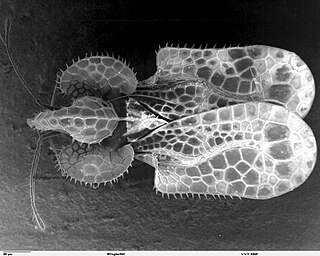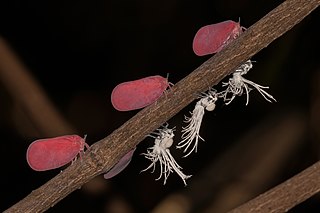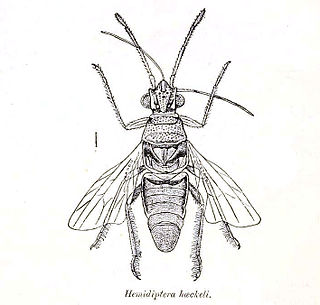
In Greek mythology, the Oceanids or Oceanides are the nymphs who were the three thousand daughters of the Titans Oceanus and Tethys.
The Syndiniales are an order of early branching dinoflagellates, found as parasites of crustaceans, fish, algae, cnidarians, and protists. The trophic form is often multinucleate, and ultimately divides to form motile spores, which have two flagella in typical dinoflagellate arrangement. They lack a theca and chloroplasts, and unlike all other orders, the nucleus is never a dinokaryon. A well-studied example is Amoebophrya, which is a parasite of other dinoflagellates and may play a part in ending red tides. Several MALV groups have been assigned to Syndiniales; recent studies, however, show paraphyly of MALVs suggesting that only those groups that branch as sister to dinokaryotes belong to Syndiniales.

Pentatominae is a subfamily of Pentatomidae, a family of shield bugs. This subfamily is the largest one within the Pentatomidae, having 4937 species classified in 938 genera. Species in this subfamily are phytophages and several of them are considered agricultural pests. Some invasive pentatomines such as Halyomorpha halys and Bagrada hilaris have been considered household pests. Higher systematics of the group have been revised by Rider et al.

The Cimicomorpha are an infraorder of insects in the order Hemiptera, the true bugs. The rostrum and other morphology of all members apparently is adapted to feeding on animals as their prey or hosts. Members include bed bugs, bat bugs, assassin bugs, and pirate bugs.

The Oceanides, Op. 73, is a single-movement tone poem for orchestra written from 1913 to 1914 by the Finnish composer Jean Sibelius. The piece, which refers to the nymphs in Greek mythology who inhabited the Mediterranean Sea, premiered on 4 June 1914 at the Norfolk Music Festival in Connecticut with Sibelius conducting. Praised upon its premiere as "the finest evocation of the sea ... ever ... produced in music", the tone poem, in D major, consists of two subjects, said to represent the playful activity of the nymphs and the majesty of the ocean, respectively. Sibelius gradually develops this material over three informal stages: first, a placid ocean; second, a gathering storm; and third, a thunderous wave-crash climax. As the tempest subsides, a final chord sounds, symbolizing the mighty power and limitless expanse of the sea.
Roy Kirkaldy was an Australian professional rugby league footballer who played in the 1930s and 1940s, and coached in the 1940s. He played for Canterbury-Bankstown and for the New South Wales Rugby League team.

George Willis Kirkaldy was an English entomologist who specialised on Hemiptera. He was a Fellow of the Royal Entomological Society from 1893.

The Kirkaldy Testing Museum is a museum in Southwark, south London, England, in David Kirkaldy's former testing works. It houses Kirkaldy's huge testing machine, and many smaller more modern machines. It is open on the first Sunday of each month.
The 1891 Open Championship was the 31st Open Championship, held 6 October at the Old Course at St Andrews, Fife, Scotland. Hugh Kirkaldy won by two strokes from his brother Andrew Kirkaldy and Willie Fernie. This was the last Open Championship contested in a single day over 36 holes. The 1892 Open was contested over 72 holes played on two successive days.

Andrew Kirkaldy was a Scottish professional golfer who played during the late 19th and early 20th centuries. He was a frequent competitor in the Open Championship, finishing in the top-10 on 14 occasions. His best finish came in 1889 when he was second. He tied for first place in the event but lost a playoff to Willie Park Jr.

Dinophyceae is a class of dinoflagellates.

Cercopidae are the largest family of Cercopoidea, a xylem-feeding insect group, commonly called froghoppers or spittlebugs. They belong to the hemipteran suborder Auchenorrhyncha. A 2023 phylogenetic study of the family suggested the elevation of subfamily Ischnorhininae to full family status as Ischnorhinidae, leaving a monophyletic Cercopinae.

Flatidae are a family of fulgoroid planthoppers. They are cosmopolitan in distribution and are distinguished from others in the superfamily by a combination of characters. Like all other planthoppers, they suck phloem sap of plants. Some species are known to communicate with vibrations through the plant stems. Communication may be with mates, or with ants that tend the nymphs, protecting them and gathering honeydew secretions. Adults of some species have brightly coloured forewings which are tougher and known as tegmina unlike the membranous hindwings which are used for flight. Although a few can be identified by their coloration, most species requires dissection and examination under a microscope with access to literature on already described species.
Kirkaldy is a common misspelling of the Scottish town Kirkcaldy. It is also a surname of Scottish origin. Notable people with the surname include:

Bryocorinae is a subfamily of bugs in the family Miridae.

Orsillinae is a subfamily of seed bugs in the family Lygaeidae. There are at least 110 described species in Orsillinae; the type genus is Orsillus.
Aloha is a genus of planthopper named by George Willis Kirkaldy in 1904. As of 2018, ten species are recognized:

The Flatinae are a subfamily of planthoppers, erected by Maximilian Spinola in 1839. Genera have been recorded from all continents except Antarctica: especially in tropical and subtropical regions.

The Phyllocephalinae are a subfamily of shield bugs erected by Amyot and Serville in 1843.













